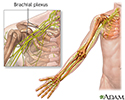Brachial plexus
The brachial plexus is a group of nerves that run from the lower neck through the upper shoulder area. These nerves provide the shoulder, arm, forearm, and hand with movement and sensation.
Information
Damage to the brachial plexus nerves can cause muscle and sensation problems that are often associated with pain in the same area. Symptoms may include:
Damage to the brachial plexus nerves
Brachial plexopathy is a form of peripheral neuropathy. It occurs when there is damage to the brachial plexus. This is a group of nerves that run f...

- Loss of feeling or sensation in your arm or hand
- Trouble moving your arm or hand
- Lack of muscle control in the arm, hand, or wrist
- Severe pain
References
Chad DA, Bowley MP. Disorders of nerve roots and plexuses. In: Jankovic J, Mazziotta JC, Pomeroy SL, Newman NJ, eds. Bradley and Daroff's Neurology in Clinical Practice. 8th ed. Philadelphia, PA: Elsevier; 2022:chap:105.
Chan K, Lee SK. Surgical management of adult traumatic brachial plexus injuries. In: Skirven TM, Osterman AL, Fedroczyk JM, Amadio PC, Feldscher SB, Shin EK, eds. Rehabilitation of the Hand and Upper Extremity. 7th ed. Philadelphia, PA: Elsevier; 2021:chap 45.
Standring S. Pectoral girdle and upper limb: overview and surface anatomy. In: Standring S, ed. Gray's Anatomy. 42nd ed. Philadelphia, PA: Elsevier; 2021:chap 48.
-
Brachial plexus - illustration
The brachial plexus is a group of nerves that originate from the neck region and branch off to give rise to most of the nerves that control movement in the upper limb. Injuries to the brachial plexus are common and can be debilitating. If the injury is severe it can cause weakness or paralysis of the entire upper limb.
Brachial plexus
illustration
-
Brachial plexus - illustration
The brachial plexus is a group of nerves that originate from the neck region and branch off to give rise to most of the nerves that control movement in the upper limb. Injuries to the brachial plexus are common and can be debilitating. If the injury is severe it can cause weakness or paralysis of the entire upper limb.
Brachial plexus
illustration
Review Date: 2/11/2025
Reviewed By: Joseph V. Campellone, MD, Department of Neurology, Cooper Medical School at Rowan University, Camden, NJ. Review provided by VeriMed Healthcare Network. Also reviewed by David C. Dugdale, MD, Medical Director, Brenda Conaway, Editorial Director, and the A.D.A.M. Editorial team.


